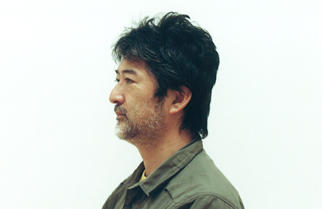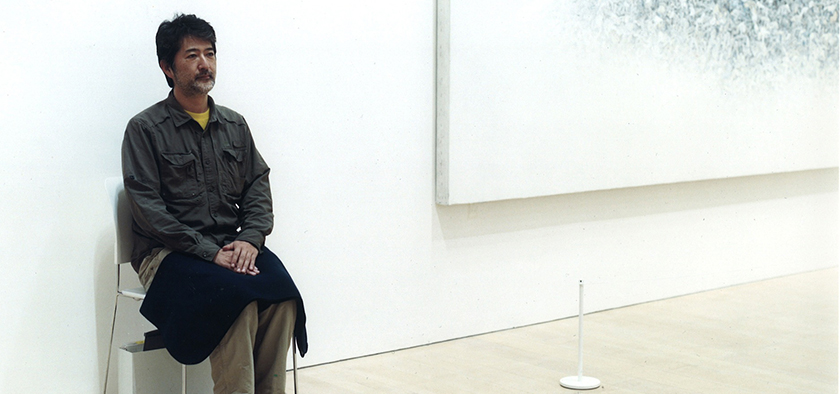
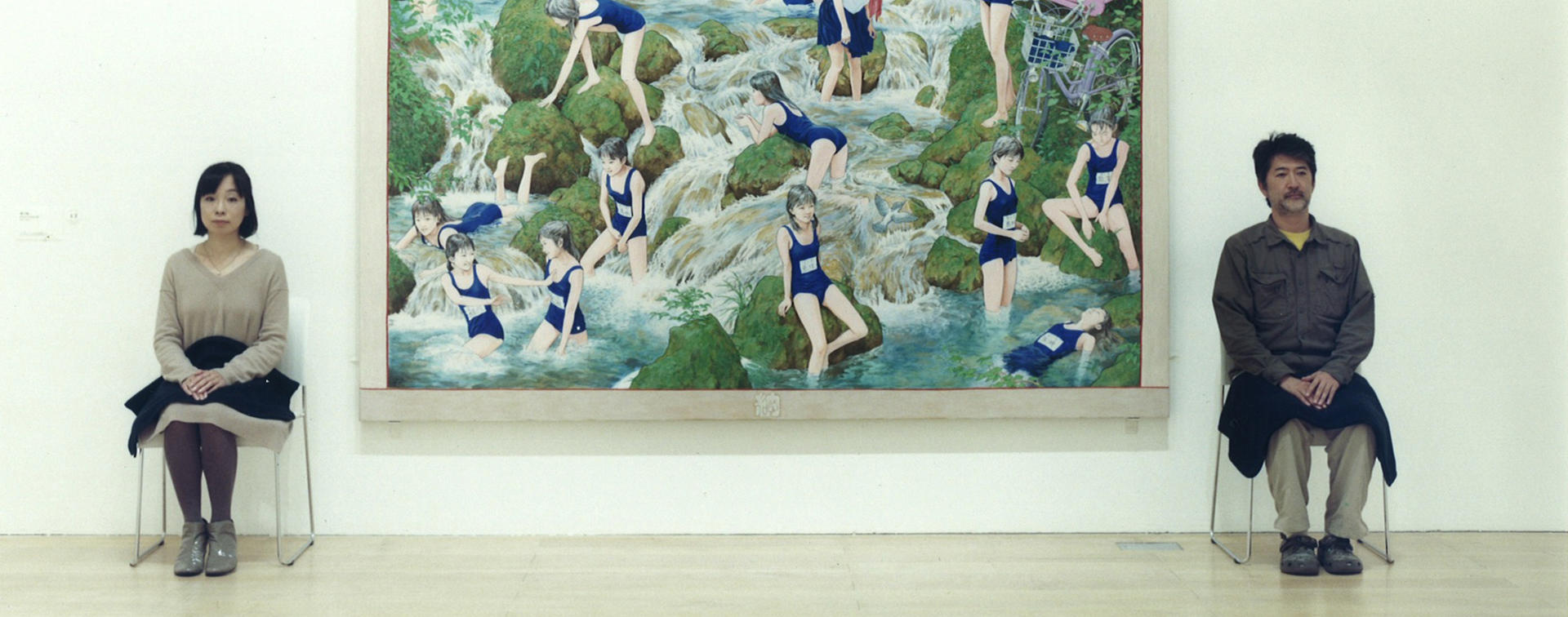
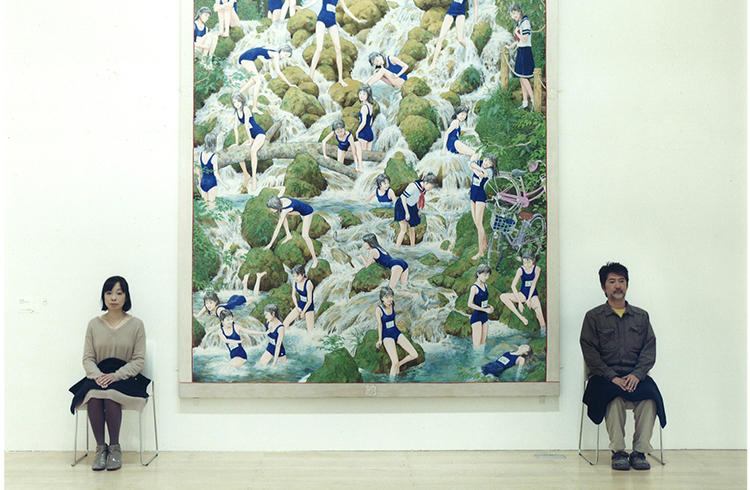
How would you turn Roppongi into an area of Design & Art?
Add “design” to the names of buildings and stations - Shinsan Create an “alternative space” to drow artists to Roppongi - Aida
Artist Makoto Aida whose "Monument for Nothing" exhibition is being held at the Mori Art Museum until March 31, 2013 in Roppongi Hills, talked with manga artist and columnist Nameko Shinsan, who is known for her distinctive perspective on society. During the talks, Shinsan made incisive comments on Roppongi and asked Aida sharp questions. Aida, who said he still has some uncompleted works on his hands and that his mind is occupied with the exhibition, kept scratching his head thoughtfully, and told us his ideas to turn Roppongi into an area of design and art.
Design-oriented Nogizaka, art-oriented Azabu Juban
AidaMy proposal for Roppongi is to create an "alternative space" in a building such as an old school building that is no longer in use. I think that this space should be used to hold the kind of exhibitions that cannot be held in art museums and also used as a casual café. With the creation of such a space, young artists would probably come to Roppongi more frequently. I'm afraid it's a commonplace proposal, but it's the only thing I can come up with right now. Shinsan-san would probably have a more unique idea.
ShinsanYou are setting the hurdle higher for me! (laughs) Alright.. I would propose changing the name of Tokyo Midtown to "Mid Design Town" or changing the name of the Roppongi station to "Design Town Roppongi". It may not be chic, but by adding the word "design" I think that the image of Roppongi as a town of design would be imprinted on people's minds.
On the Oedo Line, there are trains announcements where information is given about the areas near the stations. For example, they say, "This is the stop for Toyo Eiwa Jogakuin." If they said, "The next station is Design Town Roppongi", I think it will have an advertising effect. Another thing I would propose is doing something about Donki (Don Quijote discount shop) and the Roi Building...
AidaWhat, Donki?
ShinsanDonki sells goods that are not properly designed and the area around the shop feels unsafe. There's a negative atmosphere wafting from that place, so I think it is better if it were isolated. When some kind of step like that is taken, I think Roppongi would become a more sophisticated place.
AidaAh, I see. In my eyes though, Donki isn't that bad. Art and design are like water and oil in some ways, and there's a tricky conflict between the two. Young art people don't go to fashionable, expensive places that young design people go to. The art types have a knack for finding cheap places.
I suppose the area from Roppongi to Nogizaka is more stylish. There's the office owned by photographer Kishin Shinoyama, and there is a cultured atmosphere. Compared to that, I suppose the area around Donki isn't quite... but I rather like that area. Perhaps that area from Donki to Azabu Juban is suited for the art people.
ShinsanThere was the place called "Traumaris" which art people went to. Was that located in that area?
AidaYes. It used to be on the Imoarai-zaka slope. That neighborhood is a very comfortable place for art people like myself.

Traumaris
A small bar and art gallery with floor space of around 40 square meters that stood at the bottom of the Imoarai-zaka slope. It closed in 2008, but was loved by many artists including the late Toshiko Okamoto (wife of artist Taro Okamoto) who was its first patron. It was relocated to Ebisu in 2010.
http://www.traumaris.jp
American and Kansai elements in Roppongi
AidaWhen I was in my late twenties, I worked for about two years as a waiter at a jazz restaurant in Roppongi called "Satin Doll." So Roppongi is a place I came to for work and not amusement. To me, Roppongi seems to have an American atmosphere.
ShinsanI agree. There's even the Seijoki Dori (Stars and Stripes Road).
AidaThe U.S. embassy is nearby, and there are still some U.S. military facilities. The American soldiers are not sleek New Yorkers, but are more like coarse men from Colorado. They are slightly wild and maybe that's a trait that is not designer-like.
ShinsanThis summer, I went to a "Friendship Day" event held at a U.S. military residential compound. It was an event where American soldiers were frying meat and selling them, and everyone seemed to be a bit wild. Even though the word "friendship" was used for the event, we weren't allowed to go inside the buildings. There was a garden and I was surprised that such a large area of space in Roppongi is being used by the U.S. military.
AidaI wonder if we could get the cooperation of the French people to remove the local American atmosphere from Roppongi.
ShinsanApparently Kagurazaka is a town that has many French people. I wish the French residents there would move to Roppongi.
AidaHow about relocating the La Maison Franco-Japonaise to Roppongi?
ShinsanThat sounds good.
AidaTalking with you, I just remembered something. I think that compared to other places in Tokyo, Roppongi has more people who talk in the Kansai dialect. When I was working as a waiter in Roppongi, I often heard men talking loudly in the Kansai dialect. It all seemed wild and brazen. The American soldiers and the sound of the Kansai dialect seemed to make the place feel doubly garish, and it frightened me a bit. Yet that was the characteristic of Roppongi and I thought it was an interesting place in its own way.
We are getting farther and farther away from the topic of making Roppongi into an area of design and art...

An international alternative space
AidaGoing back to my proposal on making an alternative space, I think it would be nice if this space could be for international exchange since this is Roppongi. I think people would happily use the space if it was international, and if it was the sort of place where art students could go to try their English conversation skills. There's the "3331 Arts Chiyoda" in Akihabara, so to differentiate it from that, the space should be international.
Even though I'm making this proposal, I personally see myself as being an artist in Japan who has the least likelihood of ever communicating with people from other countries. I've resigned myself to this fact.
ShinsanAt your current exhibition, there's a written declaration on display titled "How to become the world's greatest artist" in which you say that it's not necessary to study English.
AidaAh. Well, that's because it's just not possible for my brain to absorb English. So I wrote that as a sort of self-affirmation...
ShinsanI myself cannot speak English even though I've studied it, and I'm on the verge of giving up. And I thought, "Maybe I don't need to study English any more if Aida-san is saying that it's not necessary." I felt reassured reading what you wrote.
AidaI'm sorry to hear that. But my message to young people in real life is not to become like me. My generation is the very last generation that can get away with not learning English. The next generation can't get away with it. Whether you like it or not, people are going to have to be active in a comprehensive way from now on, both in Japan and abroad. So actually, I do think that international exchange is necessary.
ShinsanWhen you go to the bars in places in Roppongi Hills, you see a lot of foreigners who work at foreign companies. Many are at the "Heartland" bar or bars that serve fish and chips, or in the sports bars. Maybe if you install a huge screen and show soccer games or F1, you would be able to draw lots of foreigners.
Oh, but they may not all like art..
AidaYes, that's the point. There is even one theory that holds that Europeans can be divided into two types - those that like soccer and those that like art - and that those like both soccer and art are rare.
ShinsanSo there are different breeds. In that case, I guess you shouldn't show soccer. But I get the feeling that among the people who work at foreign companies, there may be some who are financially well-off and would be interested in buying artworks. So perhaps there needs to be a place where foreign people can come and buy them.
AidaThere are quite a lot of contemporary art galleries in Roppongi. The old ones are places like Hosomi Gallery and Roentgenwerke. Recently, new art galleries such as Ota Fine Arts and Taka Ishii Gallery have opened near Roppongi Hills.
The presence of commercial art galleries can make a difference in whether a town is an art town or not. When you go to other countries, you often find that the innovative and ambitious art galleries tend to move out to the suburbs where the rents are cheaper; on the opening day of such a gallery, people get there by car. But in Japan, art galleries need to be near the subway station. Otherwise collectors won't come. That's why it's difficult for art galleries to move away from the center of Tokyo.
ShinsanYou talked earlier about utilizing unused school buildings. In the center of Tokyo it might be possible to cheaply rent abolished school buildings in the way that Taito Designers Village and Ikejiri Institute of Design are doing. I don't know about such schools in Roppongi, but I've heard that the Azabu Police Station will be relocated in the future.
AidaThe rents for the former site of the Azabu Police Station might be expensive.
ShinsanI hope people don't come to surrender themselves to the police, unaware that the police station has moved.
Spas for artists and for drawing people to a town
ShinsanSpeaking of utilizing vacant land, there used to be a natural hot spring opposite Roppongi Hills called "zaboo" which I often went to. I think they should build a spa again at that site considering the trouble they went to in making the hot spring in the first place. A spa has the power to draw people to a town. In Tokyo you only have "LaQua" in Korakuen and "Oedo Onsen Monogatari" in Odaiba or the luxurious and expensive type of spas.
I would certainly recommend building spas for town development. It would be nice if you could have artists draw paintings on the walls. Maybe a spa could be made on the ground floor and artists could have their ateliers on the upper floors. There's a bath house called "I Love Yu" in Naoshima, Kagawa Prefecture which was designed by Shinro Otake-san. If there was a similar spa in Roppongi I would definitely like to use it.
AidaIt would be good to have a spa which both men and women could use together, wearing swimsuits and having drinks.
ShinsanHow about carrying the water from the hot springs from Kusatsu to Roppongi? Or perhaps you could turn the pond in Hinokicho Park into a spa. It would also be good if a spa could be made in the Mohri garden in Roppongi Hills.
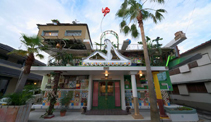
I Love Yu
An art facility and bath house designed by artist Shinro Otake. Hand-painted tiles are used for images on the bathroom walls and for mosaic pictures, as well as for the ceramic toilets.
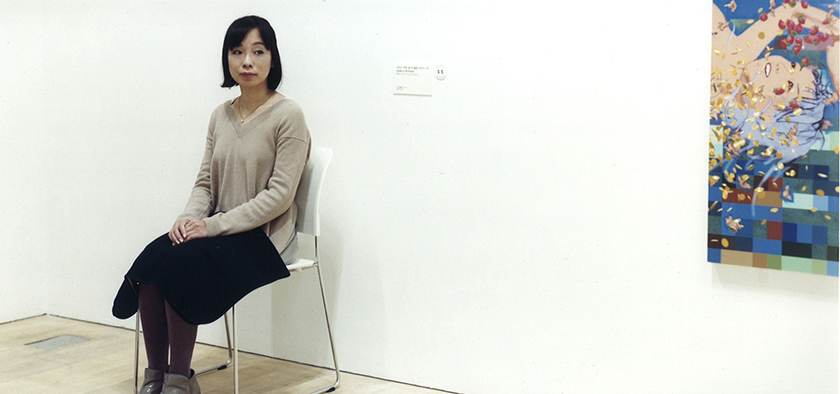
A town with a wide range of elements
AidaMy favorite towns are Latin towns. The maze of alleys tucked away in the Barcelona port or a poor Brazilian neighborhood where shirtless old men are sitting in front of beer cases in the daytime, absent-mindedly drinking Corona beer - such places appeal to me. I like places where there is a sense of carelessness - places which have distanced themselves from economic competitiveness.
I'm from the north of Japan and have a naturally gloomy personality, so if I liked towns that were similar to me, I would probably like Northern Europe and countries like Lithuania where the suicide rate is high. But when I go to Lithuania, I get the urge to go home quickly.
ShinsanI like Taito-ku in Tokyo. It's near where I live. It has a wide range of things: museums and art museums, and also places where laborers gather. An increasing number of art galleries and stylish shops are opening in Taito-ku, and I think there will be further development in the future.
I've talked to rich people who live in Minato-ku and they tell me that they basically don't go outside of Minato-ku. There is certainly a high-grade feel in Minato-ku, and I think it's a nice place, but I think it's a pity not to venture out to other places. There are all kinds of places in Tokyo. I think it would be nice if Roppongi, which is also a part of Minato-ku, could come to encompass a wider range of elements.
Things on the two people's minds
ShinsanI'm always interested in trends and social phenomena. What piques my curiosity these days is the fad for pancakes. There are many pancake shops now and people are even lining up to eat at such shops. Pancakes are made of carbohydrates and sugar and fat. Right after you eat them, your energy level might rise, but I think that all in all, pancakes are not very good for your body. But why, at this present time, do the Japanese people want pancakes? And the men have this craze for ramen which seems to be just as ardent as the [women's] craze for pancakes.
It seems to me that people are getting brainwashed by wheat flour, and I'm beginning to wonder if there is something addictive in it. That's what interests me right now.
AidaMy mind is totally occupied with the exhibition at the moment. There are about three works that are unfinished including "Jumble of 100 Flowers", and unless I finish them, it's impossible to proceed to the next stage. So all my thoughts now are about getting those works completed.
ShinsanTo an amateur like me, "Jumble of 100 Flowers" does not look like an unfinished piece of work.
AidaThe painting was made in a funny way. Colors were first applied by ink jet print and then I used paints to paint on top of that, and so it has become a peculiar work in both a good way and a bad way. I borrowed the help from a machine because I wanted the work to be in time for the exhibition, and I wanted the structure to be right. Because all the colors are there, it looks like a finished work at first glance. But essentially, nothing about it is finished. If I had painted that in the usual way, white, unpainted parts of the canvas would be showing. But this time, even though the work is not finished, it's in a state which can be shown to visitors, and that bothers me in a strange way... I think it's going to take quite a long time for me to really finish it. Perhaps I won't be able to complete it by the end of March which is when the exhibition closes.

Jumble of 100 Flowers
A work whose title is taken from the Japanese phrase "Hyakka Ryouran" which means "all kinds of flowers blooming in a wild, gorgeous manner". The expression is used to describe numerous talented people making various accomplishments at the same time. In the photo shoot for the interview, Shinsan posed as a guard protecting the work.
ShinsanDo you feel happiest when your work is finished?
AidaNo, the time I feel happiest is definitely not when the work is finished but when the idea first comes to me - before I start to use my hands. All the works lined up at the current exhibition were started by some motivation; there was a moment when I got the urge to make them. But the finished works that I initially saw in my mind is 10 to 100 times more magnificent than the works on display. The moment I get the idea, I have the feeling that I could change the world with the work, and I am euphoric. Then in the process of making it, the standard for the ideal is brought lower and lower, and when it's finished, I think to myself, "So this is how low it has fallen to this time." When a work is completed, I feel kind of bitter.
ShinsanAt the current exhibition, I felt that the "Onigiri Kamen" (rice ball mask) has qualities of a bodhisattva - it is very soothing.
AidaI don't know if it's a good thing for an artist to try to be balanced, but people have been saying that my exhibitions are frightening and peculiar and grotesque, and so I thought maybe I should have something to soften it up a bit. (laughs)
By the way, I have something personal to ask you, Shinsan-san. How about your happiness as a woman?
ShinsanMy happiness as a woman... Such questions [about marital bliss] are what I would like to ask you, Aida-san. I think it's remarkable how you are leading a happy family life at the same time that you have a busy career as an artist.
AidaOh, not at all.
ShinsanThere are not many people who can do both at once.
AidaYou are mistaken there. The "best couple" among artists would be Oscar Oiwa-san and his wife. His wife used to be a curator, but she quit working at the art museum when they married and has since been focusing on supporting Oscar. And then there are people like Ryoko Aoki-san and Zon Ito-san who each work as artists.
ShinsanIs that so. I thought that you and your wife were the perfect couple, but from now on, I will hold the people you mentioned in high regard as well.
Editor's thoughts
The interview was held at the Mori Art Museum - the second time we have used the museum for this series of interviews. We met Shinsan-san at the reception and went into the museum hall together where Aida-san was looking at his works with a smile on his face. During the photo shoot, Aida-san lightened up the mood with his antics such as muttering in strange languages; the aura he gave off seemed to be in line with the artworks he creates. It was interesting to hear Shinsan-san talk about utilizing the sites of former buildings. We certainly should think about breathing new life into old sites, and work toward creating new values in towns. (edit_rhino)





